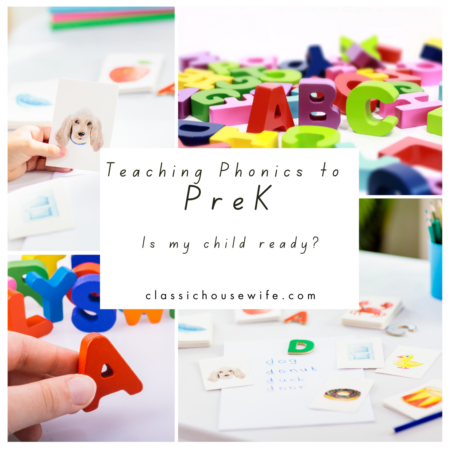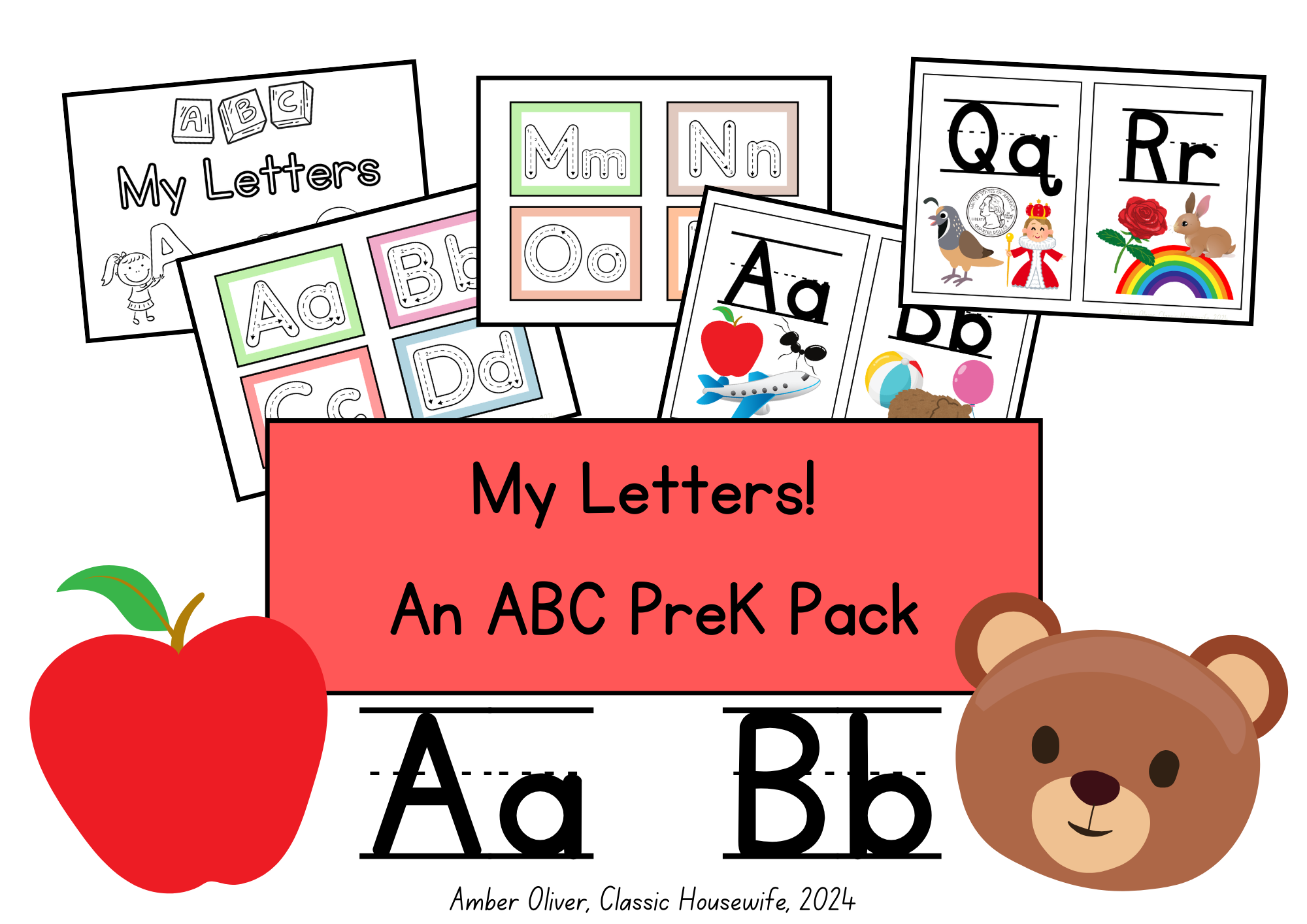
Teaching phonics to preschoolers: are they ready? That’s not a “one size” answer. (Sorry.) Whether your preschooler is ready to learn how to read or not will depend on a few key signs. But first let’s define phonics for the sake of this post.
Phonics, simply defined, is the relationship between the written letter and the audible sound made by one or more letters. “Phonics” can also refer to the method/approach of teaching reading using phonics but for the duration of this post, I’m simply referring to the sound that is represented by the letter on the paper.
Let’s Start At the Very Beginning
(humming the do re mi song)
Obviously the first step is teaching the letters of the alphabet. Most kids learn to sing the alphabet around age two, and by age three they probably recognize most of the letters. Some kids simply aren’t interested until they are older and that’s okay!
Story time: When my third child was two, he began to recognize and write letters, and by the time he was four he was reading three letter cvc words. Watching his two older sisters he seemed to pick it up rather quickly. But then just as quicky as he started, it came to a stop. He was no longer interested. We switched from “Hare Mode” to “Tortoise Mode” and a couple years later he was ready to make progress again. Learning the alphabet song and writing some letters are not the only signs that a child is really ready to learn to read.
So how do you know when your child is ready?
Ready, Set, Go!
There are several signs of readiness that you’ll see as your child’s brain gets ready to be able to do what it needs to do to learn to read. Things I noticed in all three of my older kids:
- recognition – recognizing that words and letters represent things and mean things, even if they can’t decode them yet. (You might notice your child scribbling squiggly lines on a piece of paper pretending to write a note, or finding words on something and asking what it says.)
- interest – the most important sign, a child might express interest by pretending to read a storybook, asking how to spell their name, or smiling and having fun when recognizing letters.
- memory – memory recall is an essential skill for learning phonics, and when the child’s brain is ready, you’ll notice a new growth of letter/phoneme recall. (Hey mom! That’s a B, like BALL! B B B Ball!”
When you see signs of readiness, you can start testing the waters with fun games to see how your child responds. Remember that too much pressure can squash interest, and young kids learn better while playing!
Okay, My Preschooler Seems Ready to Read, So Now What?
Yay! Now to the fun part! Teaching your kids to read is really fun. It’s also really frustrating sometimes… but it’s mostly really fun. I enjoy watching the light bulbs light up in their little minds. Some homeschool moms find the idea of teaching reading rather daunting, though. I admit there are a lot of different methods and ideas. It can be a bit confusing.
The first thing I want you to remember is this: there are many different ways to teach a child to read; there is no one right way. Also remember that kids learn at different rates, and you’re not on a deadline. Take some of the pressure off yourself!
The second thing I encourage you to do is spend plenty of time reading books to your kids. Not in an educational and instructional kind of way — just for fun. While teaching the skills for reading, don’t let them forget that reading is a fun and enjoyable way to spend time with you. As kids begin to learn letters and words, they’ll start to recognize them on the pages more often – especially with their favorite stories that you read again and again.
Three Ways to Teach Phonics to Preschoolers
Invest in a small variety of physical abc letters to manipulate.
Around age 2 when Lil Miss Mouse began recognizing letters, I started buying a variety of inexpensive letter toys like plastic magnetic letters, wooden abc puzzles, and the like. After she learned to recognize the letters we also used them to teach the sounds and start making simple words. We kept this fun, lighthearted, and playful. What I like about these types of resources are they are tangible representations of the letter that your child can hold. Children this age aren’t ready to write but they can line letters up in a row to make a word with ease.
One of my favorites that I purchased for Lil Miss Mouse a little over a year ago is this set of wooden letter abc flashcard puzzles. What I love most is that the flashcard is a puzzle for the wooden letter (so it’s very hands on) and the puzzles are self-correcting in that the letter only fits on the puzzle the correct way.
Practice what they learn by using matching games.
Matching is a skill that young kids learn pretty early, usually by the age of 3. Use that to your advantage to practice and reinforce what your child is learning, in a very game-like way.
One example is finding and matching all the same letter from multiple sets, which are most likely using different fonts, and can help your child recognize the same letter when it looks just a little bit different. Another example is using flash cards and asking your child to find the letters of the word in their plastic or wooden letter set. Alternatively, you can use abc stickers and wooden clothespins (or these plastic letter clips,) and ask your child to clip the matching letters to the card. While you’re doing this you will be sounding out and making the words together.
Tell them more than you ask them.
This is the most important thing to me – I don’t like quizzing young kids with too many questions too soon. While we are learning letters, sounds, and simple words, I do a lot of narrating and demonstrating.
Example: “This is the word cat, we need a C first, let’s find the C.” As your kids grow more confident, you can move to “This is the word cat, which letter do we need first? Yes C, which says ‘ck’,” And then later, “Oh, we know this word, will you help me sound it out? Ck-at-cat! Correct, let’s find the next one.”
If young kids feel like something is too hard or not very fun, they’re likely to lose interest. There’s so much information to learn at first–there are FORTY-FOUR phonetic sounds in the English language. That’s a lot of things to remember, so go slow and go easy. =)
Note: some people prefer to teach the letter sounds before the letter names and that’s a valid approach. It’s also important to be very crisp with your letter sounds. For example, C says “ck,” not “kuh.”
Have fun learning together!
Okay, this may actually be the most important part. If either one of you gets frustrated, it’s definitely time for a break. Attention spans run short, too, so when the attention span runs out, that’s also a sign to call it quits and move to something else.
Start with your three letter CVC words (consonant-vowel-consonant) first, which introduces the most basic phonics sounds. Other phonics sounds (like “ough”) aren’t learned until the basics are down. Also, starting with the most common letters a, e, i, m, n, p, s, t (remember: MEATPINS) is a good place to start, too.
There’s no time frame for how long it takes young kids to pick up and learn their basic phonics sounds. Your child may catch on very quickly or take more time. They may like learning simple words or they may not. Let your child dictate the pace at this age and they won’t feel rushed, pushed, or pressured. However fast they progress, celebrate the victories and keep having fun.
P.S. I have a free Preschool ABC Letters kit that you can get for free by subscribing. You can unsubscribe at anytime.
When your child is ready: check out the I Can Read pack and I Can Read 2 pack in my shop!


Thank you for sharing such practical and engaging tips! These creative strategies make teaching phonics to preschoolers fun and effective.